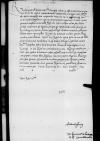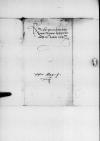List #2819
Tomasz SOBOCKI do Ioannes DANTISCUSCracow (Kraków), 1545-04-25
| odebrano Heilsberg (Lidzbark Warmiński), 1545-05-25 Rękopiśmienne podstawy źródłowe:
| ||||
Tekst + aparat krytyczny + komentarz Zwykły tekst Tekst + komentarz Tekst + aparat krytyczny
Reverendissimo in Christo Patri et Domino, domino
Reverendissime in Christo Pater et Domine colendissime.
Praemissa salute ac observantiae meae in gratiam Reverendissimae Dominationis Vestrae commendatione.
Tametsi mihi perexigua cum Reverendissima Dominatione Vestra intercessit vitae consuetudo, tamen et ex ea, quantacumque fuit, animi eiusdem singularem erga me propensionem cognoscere licebat. Quam opinionem eiusdem in me animi Reverendissima Dominatio Vestra scriptis ad me suis cf.
Quod vero Reverendissima Dominatio Vestra cf.
Commendo me in gratiam Reverendissimae Dominationis Vestrae, quam diu et optime valere ex animo opto.
Datum
Vestrae Reverendissimae Dominationis servitor addictissimus


 BCz, 1599, p. 502
BCz, 1599, p. 502